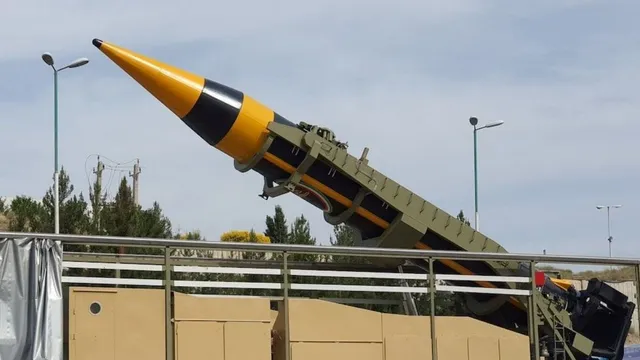- By Supratik Das
- Mon, 23 Jun 2025 12:45 PM (IST)
- Source:JND
In a sharp escalation of the larger regional conflict, Iran's Islamic Revolutionary Guard Corps (IRGC) fired a heavy barrage of missiles targeting multiple Israeli locations. The IRGC launched 40 missiles, including the high-capacity Khorramshahr-4 ballistic missiles, in what was reported to be the 20th wave of Iranian missile strikes since hostilities began. The simultaneous attack occurred in the immediate aftermath of US airstrikes targeting three of Iran's most important nuclear facilities, Fordow, Natanz, and Isfahan. Iranian authorities claimed several key Israeli targets, including Ben Gurion International Airport, a biological research center, logistics hubs, and key command-and-control facilities. Iranian state television reported the use of the Khorramshahr-4 missile as the principal weapon deployed in Sunday's attack. The missile is equipped with a 1,500-kilogram warhead and a range of 2,000 kilometers, being Iran's heaviest payload among ballistic missiles.
Israeli emergency services said more than 80 individuals were injured, most with minor injuries. Some missiles fell in central and southern Israel, such as Tel Aviv, where a multistorey residential complex suffered extensive structural damage. Videos from the scene depicted widespread rubble, broken glass, and emergency crews working through the rubble.
Khorramshahr-4: Iran's Heaviest and Most Advanced Missile Yet
The Khorramshahr-4, or "Kheibar," is Iran's most advanced ballistic missile. It has been revealed in May 2023 and has a range of 2,000 kilometers and a 1,500-kilogram warhead, with improved maneuverability and advanced mid-phase navigation technology. Its hypergolic fuel provides a launch time of less than 12 minutes, and its composite body provides greater survivability against missile defense systems. The Khorramshahr-4 is modeled after North Korea's Hwasong-10 and potentially can carry nuclear warheads, but Iran hasn't officially confirmed the deployment. IRGC Aerospace Division commander Brigadier General Amir Ali Hajizadeh once mentioned the missile is of multi-warhead capability and is built to fly without conventional wings and utilizes gas thrusters for in-flight control, comparable to the North Korean Hwasong-12.
ALSO READ: 'Make Iran Great Again': Trump Hints At Tehran Regime Change As Israel-Iran War Escalates
IDF Launches Airstrikes Across Iran
The Israel Defense Forces (IDF) acted quickly, launching airstrikes against Iranian military targets. Israeli officials said dozens of strategic locations had been struck throughout western Iran, including in the cities of Qom and Yazd. Among the targets was a long-range missile base in Yazd province, marking the first such strike in the region. “In response to Iran’s aggression, the IDF has struck missile launchers and military command posts deep within Iranian territory,” the Israeli military said.
Iranian media outlets claimed that nine members of the Islamic Revolutionary Guard Corps, two of them conscripts, were killed in the Israeli airstrikes against Yazd. The IRGC acknowledged the fatalities and threatened to retaliate. “Following the aggression of the barbaric Zionist regime and its mercenaries against two military centres in Yazd city, seven IRGC members and two conscripts were martyred,” stated the IRGC message cited by Tasnim. The most recent exchange of missiles between Iran and Israel has sharply heightened tensions in the Middle East, triggering frantic diplomacy at the United Nations. Global powers have been worried by the threat of further escalation and miscalculations in a very volatile climate.The war, which started with mutual tit-for-tat aggression between Israel and Iran proxies, has also now engaged the United States and sparked concerns of an escalating regional war.

